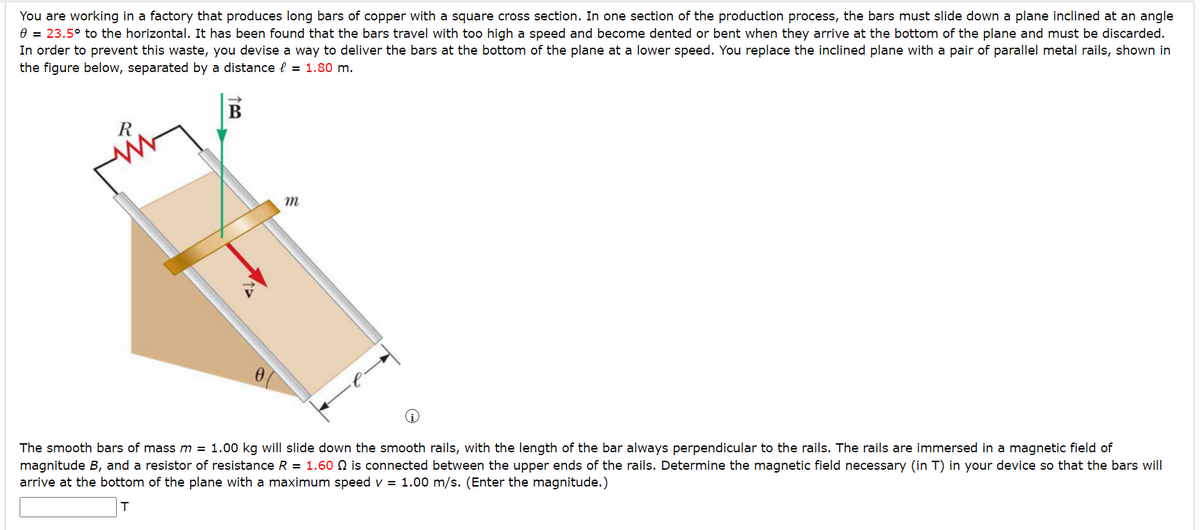You are working in a factory that produces long bars of copper with a square cross section. In one section of the production process, the bars must slide down a plane inclined at an ang 8 = 23.5° to the horizontal. It has been found that the bars travel with too high a speed and become dented or bent when they arrive at the bottom of the plane and must be discarded In order to prevent this waste, you devise a way to deliver the bars at the bottom of the plane at a lower speed. You replace the inclined plane with a pair of parallel metal rails, shown the figure below, separated by a distance = 1.80 m. teo B m The smooth bars of mass m = 1.00 kg will slide down the smooth rails, with the length of the bar always perpendicular to the rails. The rails are immersed in a magnetic field of magnitude B, and a resistor of resistance R = 1.602 is connected between the upper ends of the rails. Determine the magnetic field necessary (in T) in your device so that the bars will arrive at the bottom of the plane with a maximum speed v= 1.00 m/s. (Enter the magnitude.)
You are working in a factory that produces long bars of copper with a square cross section. In one section of the production process, the bars must slide down a plane inclined at an ang 8 = 23.5° to the horizontal. It has been found that the bars travel with too high a speed and become dented or bent when they arrive at the bottom of the plane and must be discarded In order to prevent this waste, you devise a way to deliver the bars at the bottom of the plane at a lower speed. You replace the inclined plane with a pair of parallel metal rails, shown the figure below, separated by a distance = 1.80 m. teo B m The smooth bars of mass m = 1.00 kg will slide down the smooth rails, with the length of the bar always perpendicular to the rails. The rails are immersed in a magnetic field of magnitude B, and a resistor of resistance R = 1.602 is connected between the upper ends of the rails. Determine the magnetic field necessary (in T) in your device so that the bars will arrive at the bottom of the plane with a maximum speed v= 1.00 m/s. (Enter the magnitude.)
Physics for Scientists and Engineers with Modern Physics
10th Edition
ISBN:9781337553292
Author:Raymond A. Serway, John W. Jewett
Publisher:Raymond A. Serway, John W. Jewett
Chapter30: Faraday's Law
Section: Chapter Questions
Problem 19P: You are working in a factory that produces long bars of copper with a square cross section. In one...
Related questions
Concept explainers
Ohm's law
Ohm’s law is a prominent concept in physics and electronics. It gives the relation between the current and the voltage. It is used to analyze and construct electrical circuits. Ohm's law states that the voltage across a conductor is directly proportional to the current flowing through it.
Path of Least Resistance
In a series of alternate pathways, the direction of least resistance is the actual or metaphorical route that offers the least resistance to forwarding motion by a given individual or body.
Question

Transcribed Image Text:You are working in a factory that produces long bars of copper with a square cross section. In one section of the production process, the bars must slide down a plane inclined at an angle
0 = 23.5° to the horizontal. It has been found that the bars travel with too high a speed and become dented or bent when they arrive at the bottom of the plane and must be discarded.
In order to prevent this waste, you devise a way to deliver the bars at the bottom of the plane at a lower speed. You replace the inclined plane with a pair of parallel metal rails, shown in
the figure below, separated by a distance = 1.80 m.
R
B
m
The smooth bars of mass m = 1.00 kg will slide down the smooth rails, with the length of the bar always perpendicular to the rails. The rails are immersed in a magnetic field of
magnitude B, and a resistor of resistance R = 1.60 ₪ is connected between the upper ends of the rails. Determine the magnetic field necessary (in T) in your device so that the bars will
arrive at the bottom of the plane with a maximum speed v = 1.00 m/s. (Enter the magnitude.)
T
Expert Solution
This question has been solved!
Explore an expertly crafted, step-by-step solution for a thorough understanding of key concepts.
This is a popular solution!
Trending now
This is a popular solution!
Step by step
Solved in 3 steps with 3 images

Knowledge Booster
Learn more about
Need a deep-dive on the concept behind this application? Look no further. Learn more about this topic, physics and related others by exploring similar questions and additional content below.Recommended textbooks for you

Physics for Scientists and Engineers with Modern …
Physics
ISBN:
9781337553292
Author:
Raymond A. Serway, John W. Jewett
Publisher:
Cengage Learning

Physics for Scientists and Engineers
Physics
ISBN:
9781337553278
Author:
Raymond A. Serway, John W. Jewett
Publisher:
Cengage Learning

Physics for Scientists and Engineers: Foundations…
Physics
ISBN:
9781133939146
Author:
Katz, Debora M.
Publisher:
Cengage Learning

Physics for Scientists and Engineers with Modern …
Physics
ISBN:
9781337553292
Author:
Raymond A. Serway, John W. Jewett
Publisher:
Cengage Learning

Physics for Scientists and Engineers
Physics
ISBN:
9781337553278
Author:
Raymond A. Serway, John W. Jewett
Publisher:
Cengage Learning

Physics for Scientists and Engineers: Foundations…
Physics
ISBN:
9781133939146
Author:
Katz, Debora M.
Publisher:
Cengage Learning

Classical Dynamics of Particles and Systems
Physics
ISBN:
9780534408961
Author:
Stephen T. Thornton, Jerry B. Marion
Publisher:
Cengage Learning

University Physics Volume 3
Physics
ISBN:
9781938168185
Author:
William Moebs, Jeff Sanny
Publisher:
OpenStax